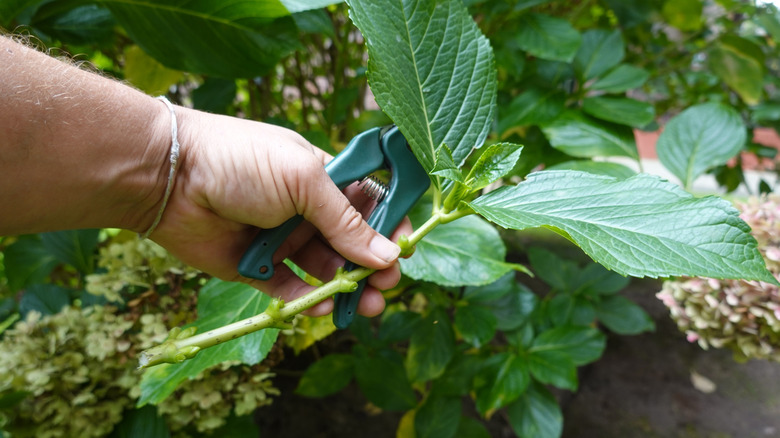The Critical Step You're Missing To Help Propagate Your Hydrangeas Perfectly
We may receive a commission on purchases made from links.
If you love the hydrangeas growing in your garden, you've probably considered starting some additional plants and whether you should use water versus soil for propagation. Propagating hydrangeas is actually quite easy as long as you follow a few basic guidelines. You want to ensure you take softwood cuttings, around 5 to 6 inches long, from new season growth that hasn't produced a flower bud. When preparing your cuttings, remove the lower leaves and only leave one or two pairs at the top. But, there's one critical step you shouldn't miss to get the best success, and that is to cut the large remaining leaves at the top in half, width-wise.
This is a trick that professional propagators use all the time when dealing with large-leafed plants such as hydrangeas, and there's a very good reason for this. You see, plants lose moisture through their leaves in a process referred to as transpiration. By reducing the size of the leaves, you're effectively limiting the amount of moisture loss your cuttings will suffer. This allows them to put all their energy into growing roots and helps to keep the remaining leaf sections hydrated. An important thing to remember here is that you must sterilize your pruning shears before you do this because you don't want to introduce any disease to the cut edges. Just wipe the blades with some rubbing or isopropyl alcohol. On a side note, did you know it's illegal to propagate a pistachio hydrangea?
Other tips to propagate hydrangeas perfectly
Instagrammer BotanicKing cuts the base of each stem at a 45-degree angle below the lowest leaf nodes. It is similar to a trick that professional propagators use, which is to wound a very small section of the stem near the nodes to expose the inner cambium layer. Doing this encourages the plant cells to initiate root formation by generating the hormones needed to make this possible. However, contrary to the advice given in the clip, you shouldn't allow the cuttings to dry out. It's much more prudent to dip the ends of the stems into some rooting hormone before inserting them into the vermiculite.
You also don't have to go out and buy plastic cups to propagate your hydrangeas. If you have a few small plant pots in your garage or some seedling trays, you can repurpose these instead. Just make sure you wash them and then sterilize them with a water and bleach solution. Or, you could use any plastic takeout containers you might have. Add some drainage holes to the bottom and fill these with vermiculite, like Burpee Organic Horticultural Vermiculite. You can even put multiple cuttings into larger containers and then repot them once roots have formed. You also want to keep your cuttings well-hydrated by placing a plant cloche or plastic bag over the top and removing it once roots have formed. Finally, you might like to successfully grow hydrangeas from just leaves with a genius gardening hack.
